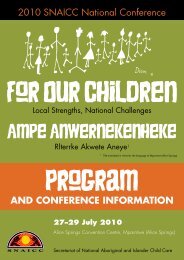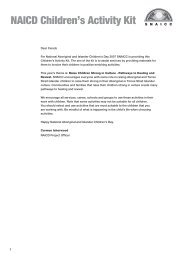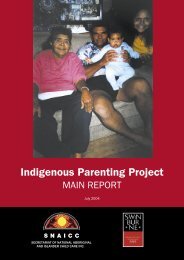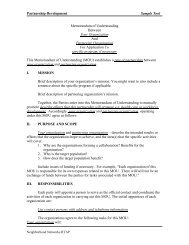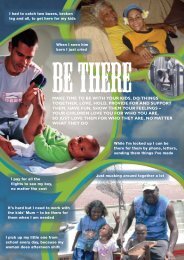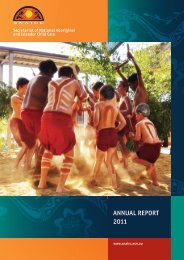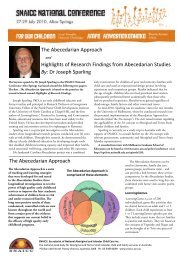A springboard for learning - Secretariat of National Aboriginal and ...
A springboard for learning - Secretariat of National Aboriginal and ...
A springboard for learning - Secretariat of National Aboriginal and ...
Create successful ePaper yourself
Turn your PDF publications into a flip-book with our unique Google optimized e-Paper software.
‘The Dreaming’ DVD<br />
Dreaming Stories:<br />
A <strong>springboard</strong> <strong>for</strong> <strong>learning</strong><br />
Jenni Connor<br />
Includes:<br />
<strong>Aboriginal</strong> <strong>and</strong> Torres Straits Isl<strong>and</strong>er people are warned<br />
that this book may contain images <strong>of</strong> deceased persons.<br />
www.earlychildhoodaustralia.org.au<br />
Research in Practice Series
About Early Childhood Australia<br />
Early Childhood Australia actively promotes<br />
the provision <strong>of</strong> high quality services <strong>for</strong> all<br />
young children from birth to eight years <strong>and</strong><br />
their families, <strong>and</strong> supports the important<br />
role <strong>of</strong> parents. Early Childhood Australia<br />
is also the national umbrella organisation<br />
<strong>for</strong> children’s services <strong>and</strong> a leading early<br />
childhood publisher.<br />
About the Research in Practice<br />
Series<br />
The Research in Practice Series is published<br />
four times each year by Early Childhood<br />
Australia.<br />
The series aims to provide practical, easy to<br />
read, up-to-date in<strong>for</strong>mation <strong>and</strong> support to a<br />
growing national readership <strong>of</strong> early childhood<br />
workers. The books bring together the best<br />
in<strong>for</strong>mation available on wide-ranging topics<br />
<strong>and</strong> are an ideal resource <strong>for</strong> children’s services<br />
workers <strong>and</strong> others interested in the care<br />
<strong>and</strong> education <strong>of</strong> young children.<br />
Series Editor<br />
Julian Fleetwood<br />
About SNAICC <strong>and</strong> the SNAICC<br />
Resource Service<br />
The <strong>Secretariat</strong> <strong>of</strong> <strong>National</strong> <strong>Aboriginal</strong> <strong>and</strong><br />
Isl<strong>and</strong>er Child Care, SNAICC, <strong>for</strong>mally<br />
established in 1981, is the national nongovernment<br />
peak body in Australia<br />
representing the interests <strong>of</strong> <strong>Aboriginal</strong> <strong>and</strong><br />
Torres Strait Isl<strong>and</strong>er children <strong>and</strong> families.<br />
In 2005 SNAICC received funding through<br />
the Australian Government’s Early Childhood<br />
- Invest to Grow Initiative <strong>of</strong> the Stronger<br />
Families <strong>and</strong> Communities Strategy to<br />
establish a national Indigenous family <strong>and</strong><br />
children’s resource service, which was <strong>of</strong>ficially<br />
named the SNAICC Resource Service (SRS)<br />
in 2006.<br />
The SRS works across the family <strong>and</strong> children’s<br />
services sector with <strong>Aboriginal</strong> <strong>and</strong> Torres<br />
Strait Isl<strong>and</strong>er community-based services <strong>and</strong><br />
other services working directly with <strong>Aboriginal</strong><br />
<strong>and</strong> Torres Strait Isl<strong>and</strong>er children to produce<br />
<strong>and</strong> distribute resources <strong>and</strong> in<strong>for</strong>mation in<br />
four priority areas.<br />
The Dreaming Stories: A <strong>springboard</strong> <strong>for</strong><br />
<strong>learning</strong> RIPS publication fits under SRS<br />
Priority Area One: Early childhood<br />
development, parenting <strong>and</strong> child rearing.<br />
Edition Editors<br />
Graphic Design<br />
Photographs<br />
Stacey Campton<br />
Jim Castro<br />
Kate Brennan<br />
Courtesy <strong>of</strong> Kura Yerlo<br />
Children’s Centre <strong>and</strong><br />
Woodville Gardens<br />
Preschool<br />
Andrew Sikorski<br />
Early Childhood Australia Inc.<br />
PO Box 7105 Watson ACT 2602<br />
T: (02) 6242 1800 F: (02) 6242 1818<br />
Sales line: 1800 356 900 (freecall)<br />
E: eca@earlychildhood.org.au<br />
© Copyright 2007<br />
All rights reserved by<br />
Early Childhood Australia Inc. <strong>and</strong> SNAICC<br />
Material herein must not be reproduced<br />
in any <strong>for</strong>m without the written permission<br />
<strong>of</strong> Early Childhood Australia Inc. <strong>and</strong> SNAICC.<br />
Registered <strong>for</strong> posting as a publication—<br />
PP232100/00036<br />
ISSN 1440-5148<br />
ISBN10 1-921162-14-7<br />
ISBN13 978-1-921162-14-5<br />
Printed by Goanna, Canberra
Contents<br />
ii<br />
About the author<br />
1<br />
Introduction<br />
4<br />
Underst<strong>and</strong>ing The Dreaming<br />
6<br />
Choosing the stories<br />
7<br />
Stories that appealed to young children<br />
15<br />
20<br />
Stories <strong>for</strong> adults to mediate<br />
Conclusion<br />
22 References <strong>and</strong> further reading<br />
Dreaming Stories: A <strong>springboard</strong> <strong>for</strong> <strong>learning</strong>
About the author<br />
Jenni Connor has worked as a teacher, principal, superintendent <strong>and</strong> curriculum<br />
manager. She has developed national <strong>and</strong> state documents on <strong>learning</strong>,<br />
curriculum <strong>and</strong> assessment, <strong>and</strong> managed Equity Programs <strong>for</strong> schools,<br />
including Indigenous education. She has worked at all levels <strong>of</strong> education, <strong>and</strong> is<br />
highly regarded <strong>for</strong> her expertise in relation to young children <strong>and</strong> their <strong>learning</strong>.<br />
Jenni is currently teaching units <strong>for</strong> a new course in early education <strong>and</strong><br />
care at the University <strong>of</strong> Tasmania. She has written a number <strong>of</strong> publications,<br />
including co-authoring Early Childhood Australia’s Your child’s first year at<br />
school: A book <strong>for</strong> parents.<br />
ii Research in Practice Series Volume 14 Number 2 2007
Introduction<br />
‘Dreaming stories tell the origins <strong>of</strong> the environment, how the Spirit Ancestors<br />
<strong>for</strong>med <strong>and</strong> gave life to the l<strong>and</strong> <strong>and</strong> laid down the Law: structures <strong>of</strong> society,<br />
rituals to maintain the life <strong>of</strong> the l<strong>and</strong>, rules <strong>for</strong> living. Above all, Dreaming stories<br />
are the stories <strong>of</strong> the l<strong>and</strong>, living with the l<strong>and</strong> <strong>and</strong> belonging to the l<strong>and</strong>’<br />
(SNAICC, 2005, p.1).<br />
‘Mainstream educators<br />
want to be certain<br />
that materials relating<br />
to Indigenous cultures<br />
<strong>and</strong> beliefs are<br />
authentic, <strong>and</strong> they<br />
want advice<br />
on how to use<br />
them appropriately.’<br />
Dreaming Stories were originally created by Indigenous communities, <strong>for</strong><br />
Indigenous people. They play an important part in the cultural heritage <strong>of</strong> <strong>Aboriginal</strong><br />
<strong>and</strong> Torres Strait Isl<strong>and</strong>er peoples because Indigenous values, responsibilities<br />
<strong>and</strong> spiritual beliefs are woven into the Stories. Since the Stories hold great<br />
wisdom <strong>for</strong> us all, children from a range <strong>of</strong> cultural backgrounds can gain valuable<br />
underst<strong>and</strong>ings from them.<br />
Mainstream educators want to be certain that materials relating to Indigenous<br />
cultures <strong>and</strong> beliefs are authentic, <strong>and</strong> they want advice on how to use them<br />
appropriately. That is why The Dreaming series produced by <strong>Aboriginal</strong> Nations<br />
(www.ablnat.com.au) is such a valuable resource.<br />
As Keith Salvat, the series Producer, said: ‘As an education resource, The Dreaming<br />
series is regarded as the most credible <strong>and</strong> in<strong>for</strong>mative product available to<br />
Australian schools <strong>and</strong> educational institutions about <strong>Aboriginal</strong> <strong>and</strong> Torres<br />
Strait culture[s] … ’<br />
Dreaming Stories: A <strong>springboard</strong> <strong>for</strong> <strong>learning</strong>
<strong>Aboriginal</strong> Nations produced 78 episodes<br />
<strong>of</strong> The Dreaming, an animation series based<br />
on Indigenous storytelling. The stories are<br />
sourced from <strong>Aboriginal</strong> <strong>and</strong> Torres Strait<br />
Isl<strong>and</strong>er communities, in consultation with<br />
their Elders, <strong>and</strong> with permission <strong>for</strong> them to<br />
be re-told <strong>and</strong> animated.<br />
A kit containing the stories on DVD <strong>and</strong> a<br />
teachers’ guide was distributed through the<br />
<strong>Secretariat</strong> <strong>of</strong> <strong>National</strong> <strong>Aboriginal</strong> <strong>and</strong> Isl<strong>and</strong>er<br />
Child Care (SNAICC) in 2005.<br />
Sharing Indigenous stories with children<br />
prior to school age<br />
In 2006, SNAICC <strong>and</strong> Early Childhood Australia (ECA) wondered if some <strong>of</strong> the<br />
stories might be suited to younger children in childcare <strong>and</strong> preschool settings,<br />
so they initiated this research project. They thought the animation style <strong>of</strong> the<br />
production would appeal to young children, providing an introduction to <strong>Aboriginal</strong><br />
<strong>and</strong> Torres Strait Isl<strong>and</strong>er cultures <strong>and</strong> beliefs, <strong>and</strong> a <strong>springboard</strong> <strong>for</strong> discussion<br />
about significant values <strong>and</strong> ideas.<br />
As Josie Boyle, the narrator <strong>of</strong> two stories in this collection, tells us:<br />
‘When I go to schools <strong>and</strong> show these stories, both the black kids <strong>and</strong> the white<br />
kids respond in a very positive way; even those children who do not normally<br />
participate in class discussions do get involved <strong>and</strong> want to talk about the stories.<br />
‘When I visit preschools it helps to bond the children who are from different ethnic<br />
backgrounds, because they all have a common response to the stories. They laugh<br />
<strong>and</strong> see the fun <strong>and</strong> humour in many <strong>of</strong> the stories.<br />
‘For the black kids this is important because it helps the other children in the<br />
group underst<strong>and</strong> their culture at a very early age. For the white kids it helps them<br />
underst<strong>and</strong> the adventurous nature <strong>and</strong> the important things in <strong>Aboriginal</strong> culture.<br />
Generally there is a sense <strong>of</strong> pride that comes from the children that these stories<br />
are about them <strong>and</strong> about their country.’<br />
SNAICC <strong>and</strong> ECA were interested in how educators in Indigenous <strong>and</strong> other<br />
settings might use the stories <strong>for</strong> children’s <strong>learning</strong>. The result is this book, which<br />
focuses on young children, prior to school age. It complements the teachers’ guide<br />
SNAICC has distributed <strong>for</strong> Year One upwards <strong>and</strong> <strong>of</strong>fers ideas <strong>for</strong> practitioners<br />
working in the pre-school sector.<br />
Research in Practice Series Volume 14 Number 2 2007
Centres involved<br />
The centres that agreed to participate in the project were an open childcare centre<br />
in Darwin, a preschool with a culturally mixed population in South Australia, a<br />
Multifunctional <strong>Aboriginal</strong> Children’s Service (MACS) near Adelaide, two MACS in<br />
rural Victoria <strong>and</strong> an <strong>Aboriginal</strong> Child Care centre in northern Tasmania. Fourteen<br />
stories were chosen to trial in the six centres.<br />
Selected stories were copied onto DVD <strong>and</strong><br />
sent to each location with a request that staff:<br />
‹<br />
‹<br />
‹<br />
‹<br />
‹<br />
view them<br />
show them to children<br />
note children’s responses<br />
document the activities they thought<br />
appropriate <strong>for</strong> the age groups,<br />
following the viewing<br />
provide ‘words <strong>of</strong> caution’ about the suitability<br />
<strong>of</strong> particular stories <strong>for</strong> different age groups.<br />
Practitioners were invited to show the DVD to<br />
any <strong>of</strong> the children in the centre, but particularly<br />
to engage children in the three–five age group in<br />
making meaning from the stories <strong>and</strong> responding<br />
to them. This book records early childhood<br />
educators’ responses.<br />
In<strong>for</strong>mation arising from the research is<br />
organised around:<br />
‹<br />
‹<br />
‹<br />
‹<br />
brief synopses <strong>and</strong> interpretations <strong>of</strong> each<br />
story, derived from the original story narrators<br />
<strong>and</strong> other research by this writer<br />
key messages identified by centre staff <strong>and</strong><br />
this writer<br />
comments from staff in early childhood settings<br />
activities arising from the story, documented<br />
by staff.<br />
Some stories were trialled in more than one<br />
centre. The centres are not identified in connection<br />
with specific activities or comments.<br />
‘When I go<br />
to schools <strong>and</strong><br />
show these<br />
stories, both<br />
the black kids<br />
<strong>and</strong> the white<br />
kids respond in<br />
a very positive<br />
way; even those<br />
children who<br />
do not normally<br />
participate<br />
in class<br />
discussions do<br />
get involved<br />
<strong>and</strong> want to<br />
talk about<br />
the stories.’<br />
Dreaming Stories: A <strong>springboard</strong> <strong>for</strong> <strong>learning</strong>
Dreaming Stories: A <strong>springboard</strong> <strong>for</strong> <strong>learning</strong><br />
‘Dreaming stories are the stories <strong>of</strong> the l<strong>and</strong>, living with the l<strong>and</strong> <strong>and</strong> belonging<br />
to the l<strong>and</strong>’.<br />
—From Teachers’ guide: The Dreaming (<strong>Secretariat</strong> <strong>of</strong> <strong>National</strong> <strong>Aboriginal</strong><br />
<strong>and</strong> Isl<strong>and</strong>er Child Care, 2005).<br />
Experienced educator Jenni Connor worked with the <strong>Secretariat</strong> <strong>of</strong> <strong>National</strong><br />
<strong>Aboriginal</strong> <strong>and</strong> Isl<strong>and</strong>er Child Care to produce this resource <strong>for</strong> all early<br />
childhood carers <strong>and</strong> educators. This unique DVD set includes 13 short films<br />
from The Dreaming; <strong>Aboriginal</strong> Nations’ award-winning animated series.<br />
Dreaming Stories: A <strong>springboard</strong> <strong>for</strong> <strong>learning</strong> records the experiences <strong>of</strong><br />
several diverse services using the The Dreaming films to introduce young<br />
children to a huge range <strong>of</strong> concepts:<br />
• Explaining the seasons, life cycles, the importance <strong>of</strong> rain <strong>and</strong><br />
responsibility <strong>for</strong> the environment.<br />
• Appreciating diversity in appearance, language <strong>and</strong> culture.<br />
• Exploring emotional concepts such as jealousy, fairness <strong>and</strong> the value<br />
<strong>of</strong> sharing.<br />
• Encouraging communication, cooperation <strong>and</strong> teamwork.<br />
• Activities involving music, movement, art <strong>and</strong> computer design.<br />
The Dreaming Stories are an important part <strong>of</strong> <strong>Aboriginal</strong> <strong>and</strong> Torres Strait<br />
Isl<strong>and</strong>er peoples’ cultural heritage. As the world’s longest continuous record<br />
<strong>of</strong> historic events <strong>and</strong> spirituality they provide valuable wisdom <strong>for</strong> all people.<br />
To subscribe to the Research in Practice Series<br />
T: 1800 356 900 (freecall)<br />
E: eca@earlychildhood.org.au<br />
Volume 14 No.2 2007<br />
Research in Practice Series<br />
Early Childhood Australia Inc.<br />
PO Box 7105 Watson ACT 2602<br />
T: (02) 6242 1800 F: (02) 6242 1818<br />
E: eca@earlychildhood.org.au


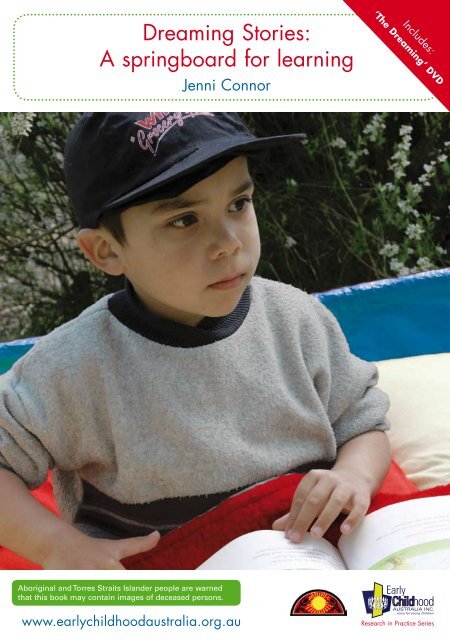
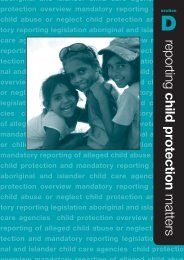

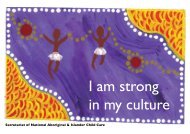
![Kukumbat gudwan daga - really cooking good food. [PDF 716 KB]](https://img.yumpu.com/47617674/1/190x134/kukumbat-gudwan-daga-really-cooking-good-food-pdf-716-kb.jpg?quality=85)
